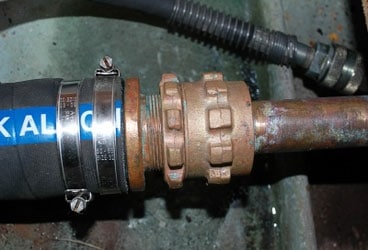
prop shaft and packing nut 368
When properly installed and adjusted, a stuffing box will provide hundreds, if not thousands, of hours of reliable, nearly leak-free service.
The keys to a stuffing box’s longevity are twofold. The first and most common cause of chronically leaky stuffing boxes involves the condition of the surface of the propeller shaft directly beneath the packing. If it’s in any way irregular, pitted, or damaged, the packing will be torn up each time the shaft rotates beneath it, which may be as many as 1,500 or 2,000 times per minute. The pitting or damage is often caused by the stuffing box’s oxygen-poor environment. If this is the case, then no amount of repacking-regardless of the type of space-age “leak-proof” material you use-or adjustment will resolve the problem. Two solutions exist: Replace the shaft, or use a longer or shorter stuffing-box hose to move the location of the packing over an undamaged section of shaft.
The second problem, which also results in chronic leakiness, is often caused by a sailor’s response to the first problem: overtightening the nut that contains the flax packing. When the nut is overtightened, the flax overheats, and the wax lubricant melts and runs out. Green or black sticky material under the box means that the stuffing box has overheated; the box must now be disassembled. Clean out all vestiges of packing and wax, then clean the shaft and lightly polish it using 400-grit emery cloth.
Overtightening the packing nut so that the stuffing box drips no water at all can wear a groove in the prop shaft and ruin it. When the shaft is spinning, the stuffing box must allow a few drops of water per minute for lubrication. A variety of formulas exist to establish the number of times a stuffing box should drip while the shaft is spinning. Forget ’em. As long as the box isn’t dripping too much and isn’t running too hot, then all is well. Some boxes, particularly those used on sailboats, need not drip at all to meet this criterion as long as the packing remains moist. Take the box’s temperature after running at cruising speed for half an hour or so; it shouldn’t be more than 20 degrees F above the ambient water temperature. If you use an infrared pyrometer, you can carry out this test while under way. If you use a contact thermometer or your hand (too hot to touch is usually between 130 F and 150 F), shift into neutral, then check the temperature right away.
After repacking the stuffing box, use two wrenches to jam the locking nut against the adjustable packing nut. Never use a single wrench for this procedure because you’ll run the risk of spinning the nut off. More wraps, by the way, aren’t better where stuffing-box packing is concerned. Most boxes work very well with just three rings of packing; place the seams or joints at angles of 120 degrees to each other. Using too many wraps causes the shaft and box to overheat, which leads to packing failure as well as to galling of the shaft.
Finally, carefully inspect the stuffing-box hose and clamps at least once every sailing season. Use only all-stainless-steel, non-perforated hose clamps; avoid using T-bolt clamps because they’re prone to crevice corrosion in this application. Replace hoses at the first sign of fatigue, every five years, or whenever the shaft is removed, whichever comes first.
Steve D’Antonio, a regular CW contributor, offers services for vessel owners, boatbuilders, and others in the marine industry through Steve D’Antonio Marine Consulting. Next month, he writes about prop-shaft alignment.








